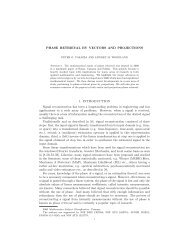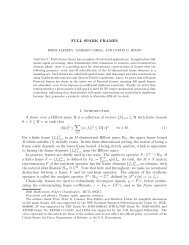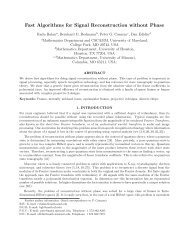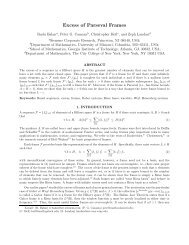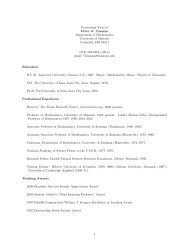Introduction to Finite Frame Theory - Frame Research Center
Introduction to Finite Frame Theory - Frame Research Center
Introduction to Finite Frame Theory - Frame Research Center
Create successful ePaper yourself
Turn your PDF publications into a flip-book with our unique Google optimized e-Paper software.
<strong>Introduction</strong> <strong>to</strong> <strong>Finite</strong> <strong>Frame</strong> <strong>Theory</strong> 29<br />
5.3 <strong>Frame</strong> Algorithms<br />
Let (ϕ i ) M i=1 be a frame for H N with frame opera<strong>to</strong>r S, and assume we are given the<br />
image of a signal x ∈ H N under the analysis opera<strong>to</strong>r, i.e., the sequence (〈x,ϕ i 〉) M i=1<br />
in l M 2 . Theorem 8 already provided us with the reconstruction formula<br />
x =<br />
M<br />
∑<br />
i=1<br />
〈x,ϕ i 〉S −1 ϕ i<br />
by using the canonical dual frame. Since inversion is typically not only computationally<br />
expensive, but also numerically instable, this formula might not be utilizable<br />
in practice.<br />
To resolve this problem, we will next discuss three iterative methods <strong>to</strong> derive<br />
a converging sequence of approximations of x from knowledge of (〈x,ϕ i 〉) M i=1 . The<br />
first on our list is the so-called frame algorithm.<br />
Proposition 18 (<strong>Frame</strong> Algorithm). Let (ϕ i ) M i=1 be a frame for H N with frame<br />
bounds A,B and frame opera<strong>to</strong>r S. Given a signal x ∈ H N , define a sequence<br />
(y j ) ∞ j=0 in H N by<br />
y 0 = 0, y j = y j−1 + 2<br />
A + B S(x − y j−1) for all j ≥ 1.<br />
Then (y j ) ∞ j=0 converges <strong>to</strong> x in H N and the rate of convergence is<br />
‖x − y j ‖ ≤<br />
Proof. First, for all x ∈ H N , we have<br />
〈(<br />
Id − 2 ) 〉<br />
A + B S x,x = ‖x‖ 2 − 2<br />
A + B<br />
Similarly, we obtain<br />
which yields<br />
By the definition of y j , for any j ≥ 0,<br />
( ) B − A j<br />
‖x‖, j ≥ 0.<br />
B + A<br />
M<br />
∑<br />
i=1<br />
|〈x,ϕ i 〉| 2 ≤ ‖x‖ 2 − 2A<br />
A + B ‖x‖2 = B − A<br />
A + B ‖x‖2 .<br />
− B − A 〈(<br />
B + A ‖x‖2 ≤ Id − 2 ) 〉<br />
A + B S x,x ,<br />
∥<br />
∥Id − 2<br />
A + B S ∥ ∥∥ ≤<br />
B − A<br />
A + B . (3)<br />
x − y j = x − y j−1 − 2<br />
(<br />
A + B S(x − y j−1) = Id − 2 )<br />
A + B S (x − y j−1 ).<br />
Iterating this calculation, we derive



